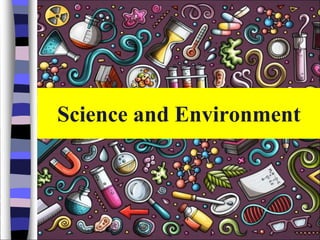
Science and environment
- 2. What is Science? Science is observing, studying and experimenting to find the nature of things.
- 3. Scientists do many things ! Scientists: – Investigate – Plan experiments – Observe – Test results
- 4. The Nature of Science Vocabulary: – Science: a system of knowledge based on facts or principles – Technology: the application of science to meet human needs – Scientific theory: a tested, possible explanation of a natural event – Scientific law: a summary of an observed natural event
- 5. Why a Scientist Performs Experiments 1. Find out something new about the natural world. 2. To explain something that is already known. 3. To check the results of other experiments. 4. To test predictions of current theories.
- 6. Science Has Many Branches Science Natural Science Social Science Biological Science: The science of the Living world Physical Science: The science of Matter and energy Earth Science: The science of Our planet Psychology Sociology Examples: Botany, zoology, ecology Examples: Physics and chemistry Examples: Geology and meteorology
- 7. Branches of Science Branch of Science Area of Study Social science Human behavior Natural science How the whole universe behaves Biology Living things Botany Plants Zoology Animals Ecology Balance in nature Physical science Matter and energy Chemistry Matter and its changes Physics Forces and energy Geology Earth’s physical nature and history Meteorology The atmosphere and weather
- 8. Science and Technology They work together and depend on one another. Science: observing, studying, & experimenting to find the nature of things Technology: using science to make human lives easier – Computers, cell phones, cars, answering machines
- 9. ENVIRONMENT
- 10. What is Environment ? The environment is something you are very familiar with. It's everything that makes up our surroundings and affects our ability to live on the earth—the air we breathe, the water that covers most of the earth's surface, the plants and animals around us, and much more.
- 13. Abiotic vs Biotic environment
- 14. Ecosystem An ecosystem is a community of living organisms in conjunction with the nonliving components of their environment, interacting as a system. These biotic and abiotic components are linked together through nutrient cycles and energy flows.